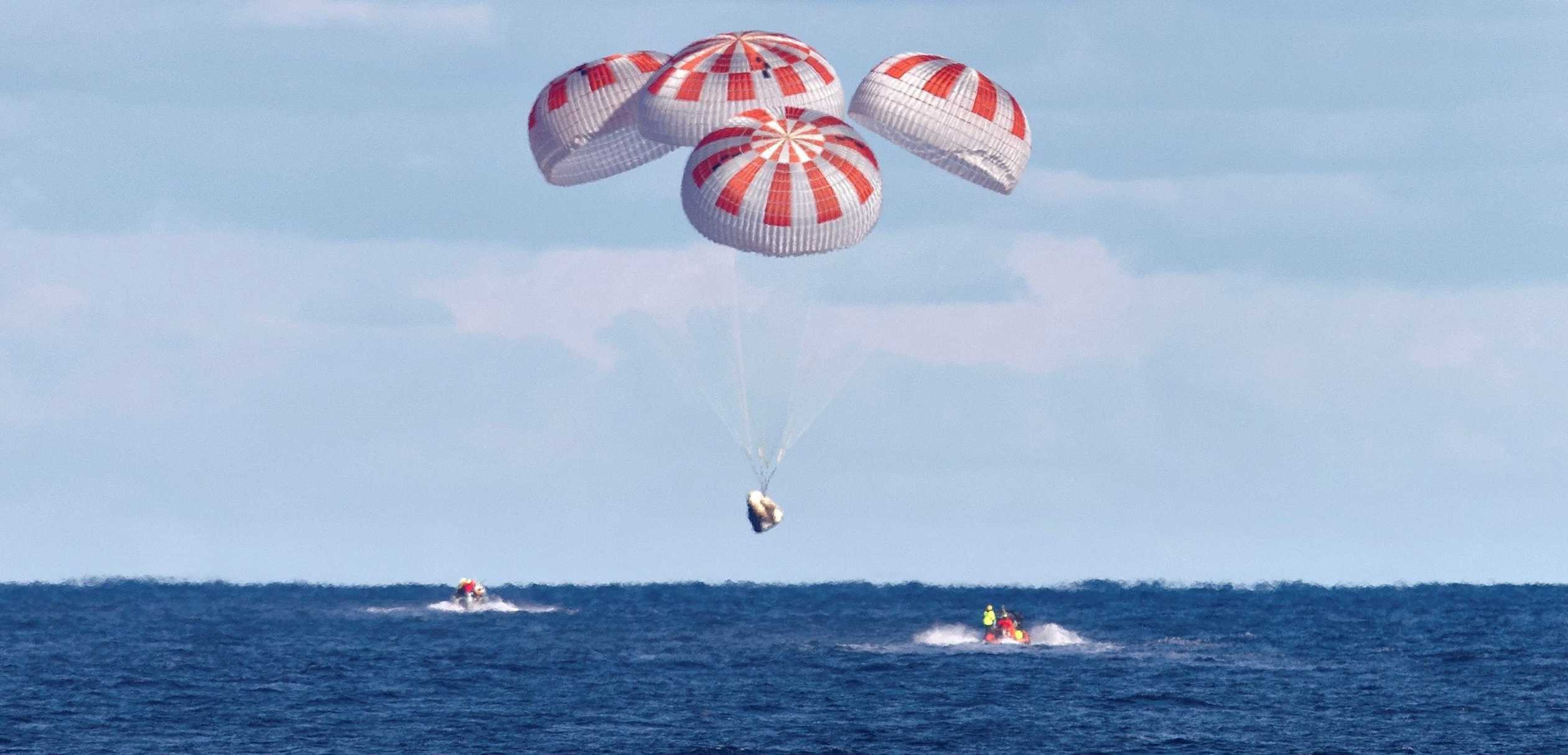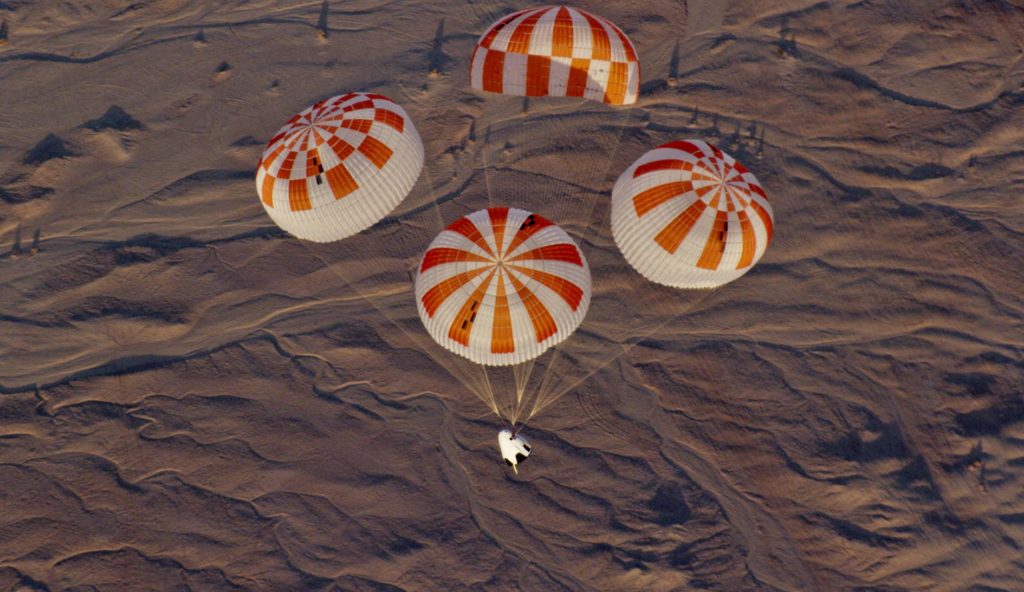

News
SpaceX Crew Dragon spacecraft nears last parachute tests before astronaut launch debut
SpaceX’s Crew Dragon spacecraft is likely just a few weeks away from its last few parachute drop tests, the successful completion of which should give NASA all the technical data it needs to okay its astronaut launch debut.
After facing several major failures during intentionally challenging drop tests both last year and the year before, SpaceX and supplier Airborne have been working relentlessly to better understand the complex physics behind parachutes and then design and build better ones with that information.
Most recently, SpaceX has been aggressively testing the latest Mark 3 (Mk3) parachute variant with great success and has completed some two-dozen consecutively-successful drop tests since October 2019. Now, NASA and SpaceX are working together to settle on a design for two final Crew Dragon parachute tests, the results of which will almost certainly determine when the spacecraft’s astronaut launch debut will occur.
As previously discussed on Teslarati, SpaceX – in pursuit of the safest and most reliable spacecraft possible – has quite literally been pushing the envelope of parachute engineering and the immensely complex physics behind their behavior during deployment.
“According to NASA, the incredibly extensive testing SpaceX has had to do to satisfy the agency’s requirements has lead the company to develop “a better understanding of how to safely design and operate parachute clusters”. As of September 2019, SpaceX has reportedly completed 48 distinct parachute tests, of which one or two apparently failed.
In response to the additional testing and analysis NASA required after a recent April 2019 chute failure, SpaceX has essentially been forced to push the state of the art of parachute design and modeling to new levels. NASA says that SpaceX has begun to model certain conditions and newfound failure modes in ways that “provide a better understanding of parachute reliability” and have forced NASA to reevaluate its own standards and certification processes. Shown in the video above, SpaceX recently completed a successful parachute test identical to the attempt that failed in April 2019, a major step towards confirming that the new parachute analysis and design have mitigated prior faults.”
Teslarati.com — September 20th, 2019
Since that NASA report, SpaceX has – based on their own subsequent updates – completed no less than 24 successful Mk3 parachute tests, ranging from single-chute and chute-out tests to the full-fidelity spacecraft launch and recovery that followed Crew Dragon’s January 19th, 2020 In-Flight Abort (IFA) test.

NASA’s Wallops Twitter account has revealed Crew Dragon’s final two parachute tests will be performed with a C-130 cargo plane similar to the one pictured above during a previous SpaceX drop test, implying – unsurprisingly – that they will likely be as closed to full fidelity as possible. For unknown reasons, those final tests will be performed in Arizona instead of SpaceX’s usual California-based locations of choice.

Most likely, those tests will involve a Crew Dragon-shaped simulator that will perform drop tests as if it were a flightworthy spacecraft returning from space. That would involve fairly high-altitude drops in which the spacecraft simulator uses mortars to eject a hatch and deploy drogue chutes, stabilizing Crew Dragon’s orientation before four main chutes are carefully deployed a gentle splashdown or touchdown.
Ultimately, if those tests go exactly as planned and NASA is able to finish reams of paperwork in time, Crew Dragon could be ready for its astronaut launch debut (known as Demo-2) as early as late-April 2020, although May or June may be more practical. In doing so, SpaceX is all but certain to become the first private company in history to launch humans into orbit.
Check out Teslarati’s Marketplace! We offer Tesla accessories, including for the Tesla Cybertruck and Tesla Model 3.

Elon Musk
Elon Musk and Tesla AI Director share insights after empty driver seat Robotaxi rides
The executives’ unoccupied tests hint at the rapid progress of Tesla’s unsupervised Robotaxi efforts.

Tesla CEO Elon Musk and AI Director Ashok Elluswamy celebrated Christmas Eve by sharing personal experiences with Robotaxi vehicles that had no safety monitor or occupant in the driver’s seat. Musk described the system’s “perfect driving” around Austin, while Elluswamy posted video from the back seat, calling it “an amazing experience.”
The executives’ unoccupied tests hint at the rapid progress of Tesla’s unsupervised Robotaxi efforts.
Elon and Ashok’s firsthand Robotaxi insights
Prior to Musk and the Tesla AI Director’s posts, sightings of unmanned Teslas navigating public roads were widely shared on social media. One such vehicle was spotted in Austin, Texas, which Elon Musk acknowleged by stating that “Testing is underway with no occupants in the car.”
Based on his Christmas Eve post, Musk seemed to have tested an unmanned Tesla himself. “A Tesla with no safety monitor in the car and me sitting in the passenger seat took me all around Austin on Sunday with perfect driving,” Musk wrote in his post.
Elluswamy responded with a 2-minute video showing himself in the rear of an unmanned Tesla. The video featured the vehicle’s empty front seats, as well as its smooth handling through real-world traffic. He captioned his video with the words, “It’s an amazing experience!”
Towards Unsupervised operations
During an xAI Hackathon earlier this month, Elon Musk mentioned that Tesla owed be removing Safety Monitors from its Robotaxis in Austin in just three weeks. “Unsupervised is pretty much solved at this point. So there will be Tesla Robotaxis operating in Austin with no one in them. Not even anyone in the passenger seat in about three weeks,” he said. Musk echoed similar estimates at the 2025 Annual Shareholder Meeting and the Q3 2025 earnings call.
Considering the insights that were posted Musk and Elluswamy, it does appear that Tesla is working hard towards operating its Robotaxis with no safety monitors. This is quite impressive considering that the service was launched just earlier this year.
Elon Musk
Starlink passes 9 million active customers just weeks after hitting 8 million
The milestone highlights the accelerating growth of Starlink, which has now been adding over 20,000 new users per day.

SpaceX’s Starlink satellite internet service has continued its rapid global expansion, surpassing 9 million active customers just weeks after crossing the 8 million mark.
The milestone highlights the accelerating growth of Starlink, which has now been adding over 20,000 new users per day.
9 million customers
In a post on X, SpaceX stated that Starlink now serves over 9 million active users across 155 countries, territories, and markets. The company reached 8 million customers in early November, meaning it added roughly 1 million subscribers in under seven weeks, or about 21,275 new users on average per day.
“Starlink is connecting more than 9M active customers with high-speed internet across 155 countries, territories, and many other markets,” Starlink wrote in a post on its official X account. SpaceX President Gwynne Shotwell also celebrated the milestone on X. “A huge thank you to all of our customers and congrats to the Starlink team for such an incredible product,” she wrote.
That growth rate reflects both rising demand for broadband in underserved regions and Starlink’s expanding satellite constellation, which now includes more than 9,000 low-Earth-orbit satellites designed to deliver high-speed, low-latency internet worldwide.
Starlink’s momentum
Starlink’s momentum has been building up. SpaceX reported 4.6 million Starlink customers in December 2024, followed by 7 million by August 2025, and 8 million customers in November. Independent data also suggests Starlink usage is rising sharply, with Cloudflare reporting that global web traffic from Starlink users more than doubled in 2025, as noted in an Insider report.
Starlink’s momentum is increasingly tied to SpaceX’s broader financial outlook. Elon Musk has said the satellite network is “by far” the company’s largest revenue driver, and reports suggest SpaceX may be positioning itself for an initial public offering as soon as next year, with valuations estimated as high as $1.5 trillion. Musk has also suggested in the past that Starlink could have its own IPO in the future.
News
NVIDIA Director of Robotics: Tesla FSD v14 is the first AI to pass the “Physical Turing Test”
After testing FSD v14, Fan stated that his experience with FSD felt magical at first, but it soon started to feel like a routine.

NVIDIA Director of Robotics Jim Fan has praised Tesla’s Full Self-Driving (Supervised) v14 as the first AI to pass what he described as a “Physical Turing Test.”
After testing FSD v14, Fan stated that his experience with FSD felt magical at first, but it soon started to feel like a routine. And just like smartphones today, removing it now would “actively hurt.”
Jim Fan’s hands-on FSD v14 impressions
Fan, a leading researcher in embodied AI who is currently solving Physical AI at NVIDIA and spearheading the company’s Project GR00T initiative, noted that he actually was late to the Tesla game. He was, however, one of the first to try out FSD v14.
“I was very late to own a Tesla but among the earliest to try out FSD v14. It’s perhaps the first time I experience an AI that passes the Physical Turing Test: after a long day at work, you press a button, lay back, and couldn’t tell if a neural net or a human drove you home,” Fan wrote in a post on X.
Fan added: “Despite knowing exactly how robot learning works, I still find it magical watching the steering wheel turn by itself. First it feels surreal, next it becomes routine. Then, like the smartphone, taking it away actively hurts. This is how humanity gets rewired and glued to god-like technologies.”
The Physical Turing Test
The original Turing Test was conceived by Alan Turing in 1950, and it was aimed at determining if a machine could exhibit behavior that is equivalent to or indistinguishable from a human. By focusing on text-based conversations, the original Turing Test set a high bar for natural language processing and machine learning.
This test has been passed by today’s large language models. However, the capability to converse in a humanlike manner is a completely different challenge from performing real-world problem-solving or physical interactions. Thus, Fan introduced the Physical Turing Test, which challenges AI systems to demonstrate intelligence through physical actions.
Based on Fan’s comments, Tesla has demonstrated these intelligent physical actions with FSD v14. Elon Musk agreed with the NVIDIA executive, stating in a post on X that with FSD v14, “you can sense the sentience maturing.” Musk also praised Tesla AI, calling it the best “real-world AI” today.








